What to Wear Hiking: A Women’s Guide to Outdoor Apparel
Wondering what to wear hiking? In this post, I share the best hiking clothes that I wear in some combination on every single hiking or backpacking trip I go on.
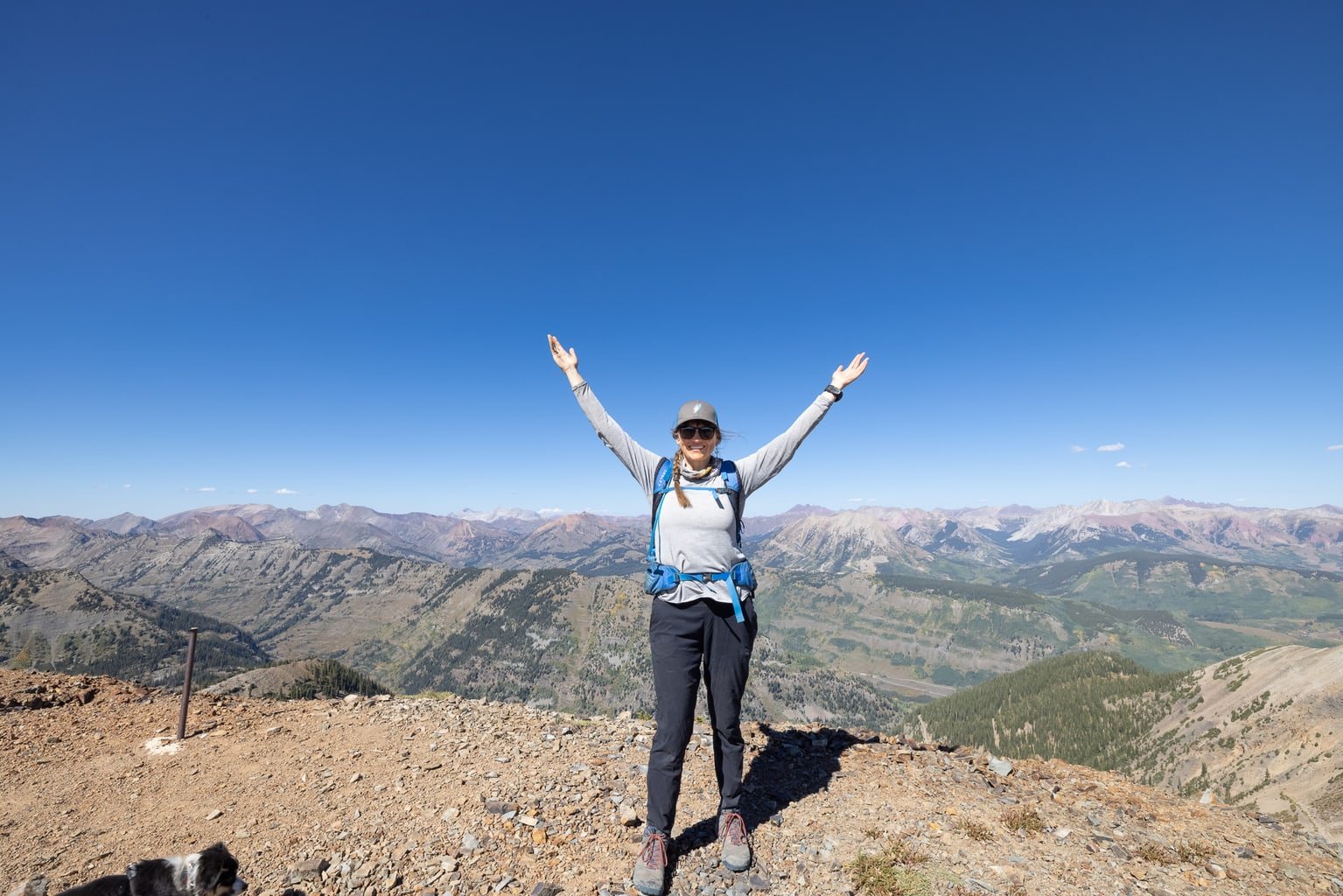
One of the most common questions I get about spending time outside is what to wear hiking. What do you need to wear to stay comfortable, dry, and safe on the trail?
Technically, hiking doesn’t require any special clothing. If you are new to hiking and starting out on short, simple trails, I recommend just dressing in the clothes that you already have. The key is to dress in layers, though, so you can add or subtract clothing as your temperature changes.
Once you start to advance to more challenging conditions and terrain, however, your hiking outfit can be the difference between having fun and being uncomfortable (and possibly unsafe) – whether that be too hot, too cold, or too wet.
I have a lot of experience hiking and backpacking and in this post, I share tips on how to dress for hikes plus some of my favorite hiking clothes that I wear time and again.
Save on Hiking Clothes this Fall
Before we get into the good stuff, don’t miss REI Co-op’s Member Days (9/12–9/22). It’s the perfect time to grab gear at a discount and maximize the Member rewards you’ll earn back later.
- Get $20 off $100+ purchases at REI Outlet online with code OUTFALL25.
- REI Co-op Mastercard holders earn 2X rewards (10%) on REI purchases – stacked on top of your regular member dividend.
- Need a tune-up? Members get 20% off Bike Tune Packages.
- Plus, enjoy 20% off used gently gear when you shop in-store.
Join the Co-op today!
REI Member Days is a great time to join! If you join the REI Co-op ($30 lifetime membership) before 11/24 and spend $50 in-store, you’ll get a $30 bonus card for a future purchase. That means your membership basically pays for itself!

On top of that, Members get 10% back every spring, a full year to return gear, and tons of other awesome perks that make it worth joining.
Disclosure: I’ve partnered with REI for years, and they remain my go-to anytime I need something for my adventures. Beyond the gear, REI has invested over $3 million since 2021 in organizations that help more people get outside – which is a cause I love supporting through my partnership with them.
This post may contain affiliate links.
Save this post!
Enter your email & I'll send this post to your inbox! You'll also receive my weekly newsletter full of helpful advice for planning your adventures.
3 Quick Tips on What to Wear Hiking
1. Dress in layers
Dressing in layers is one of the best things you can do when gearing up for a hike. Layering your clothes makes it easy to add or shed pieces depending on temperature changes or how strenuous the hike is.
Layering your top half
Most of our heat is generated from our core, so it’s important to layer our top half based on the temperatures and conditions. Here is how I think about layering up when I head out for a hike. I’ll recommend my specific products
- Closest to my body: I wear a lightweight, moisture-wicking tee or long-sleeve shirt closest to my skin. I usually opt for long-sleeves to provide sun protection.
- Mid-layer: Next, I’ll add a heavier-weight, breathable layer that I can throw on if it gets chilly.
- Outer layer: Depending on the hiking environment, I’ll pack a weather-resistant layer in case the weather turns gnarly.
Carry your layers in a daypack
You’ll want a hiking daypack that has enough room to carry your extra layers. I usually opt for a daypack with a 20-30 liter capacity. See my favorite women’s daypacks in this post.
Layering your bottom half
Depending on how cold or rainy it is, you may or may not need to layer your bottom half. I like to hike in leggings, so those are typically my next-to-skin layer. If it’s rainy, I’ll wear some lightweight rain pants over them and if it’s cold, I’ll swap my leggings for some thermal tights.
If you’ll be hiking in winter, be sure to check out my tips on cold-weather layering basics.
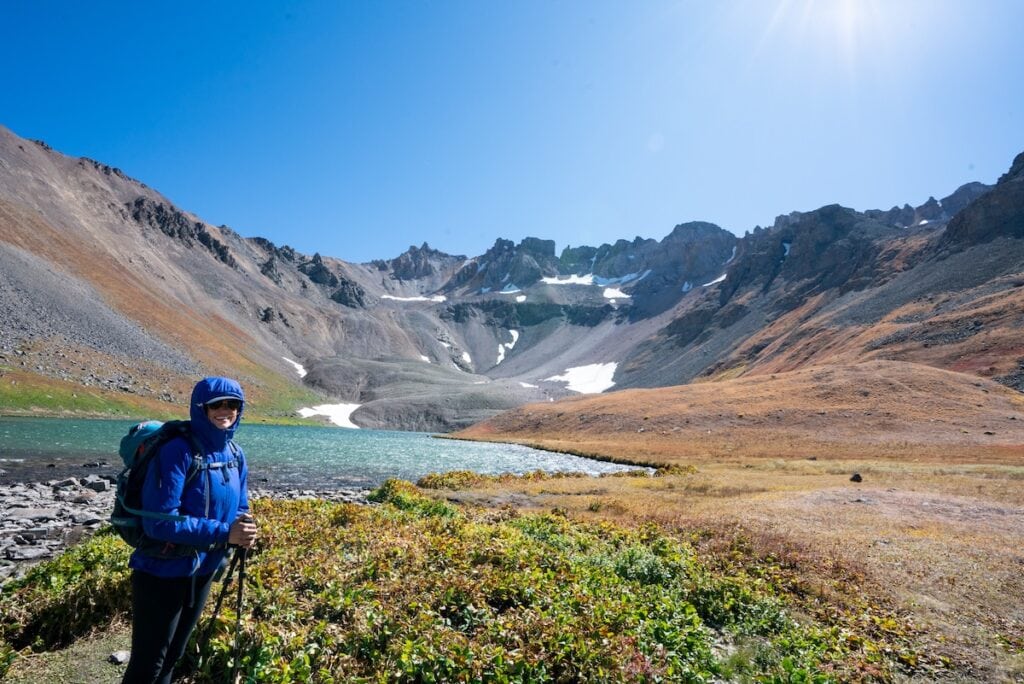
2. Choose synthetic materials
Ideally, hiking clothes should be made of moisture-wicking materials that are quick-drying. Cotton is not a good choice for hiking because it doesn’t dry quickly and can leave you feeling chilled when wet.
Synthetic materials like nylon and polyester (ideally made from recycled materials) are better choices because they are breathable and effectively wick away moisture from your body.
3. Dress for different seasons
What you choose to wear hiking should change based on the season.
- For summer hiking, it’s really important to protect your skin from the hot sun.
- Hiking in the fall and spring may mean dressing for cooler and wet conditions.
- Winter hiking will require more warm layers and insulated gear.
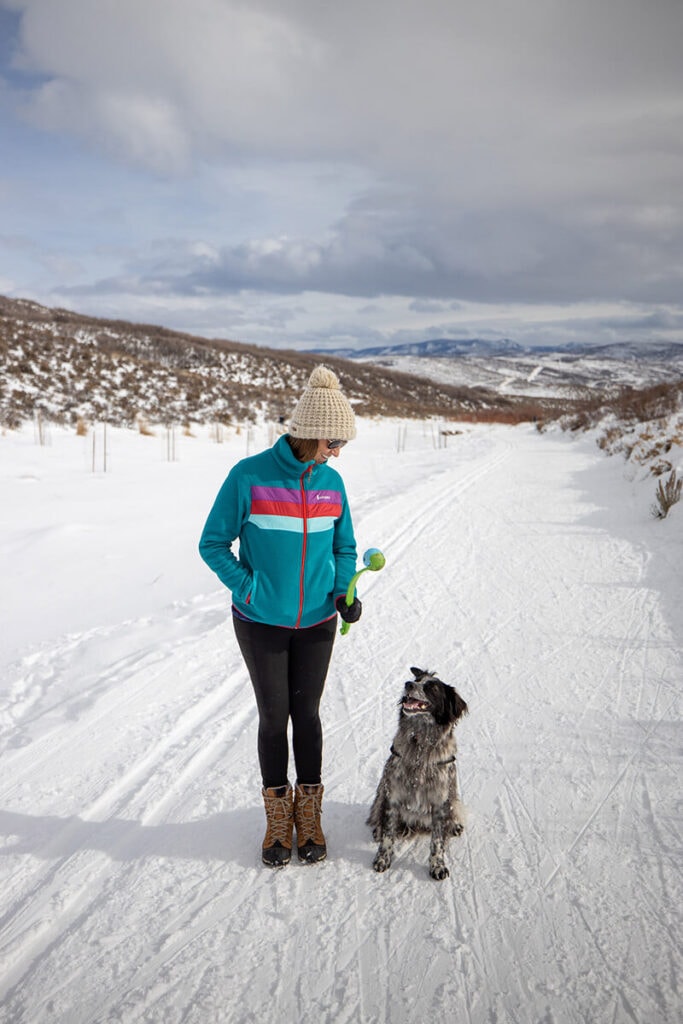


Hiking Shirts & Tops
As I mentioned above, most of our heat is generated and regulated in our core, so it’s important to choose our hiking shirts and tops carefully.
When I’m shopping for new hiking tops I make sure that they are:
- Moisture-wicking
- Made from synthetic materials (no cotton)
- Lightweight and breathable
Moisture-Wicking Hiking Tee
For hiking, I like to have a few moisture-wicking, breathable short-sleeved tees and the Patagonia Cool Capilene T-Shirt is my favorite. The Patagonia Cool Capilene shirt is also available as a long-sleeved and hooded option, which is typically what I choose for summer hiking in order to protect my skin.
It’s made from a lightweight, moisture-wicking material, so it keeps me dry and cool no matter the day. I also love that it’s designed with a basic cut and doesn’t cling to my body.
I have these tees in several colors and pretty much live in them during summer. Also, since I travel in my camper, I look for hiking shirts that can be worn several times before they need to be washed, and these shirts meet the mark.
For more summer hiking shirt options, check out my post on my favorite UPF sun protection shirts.
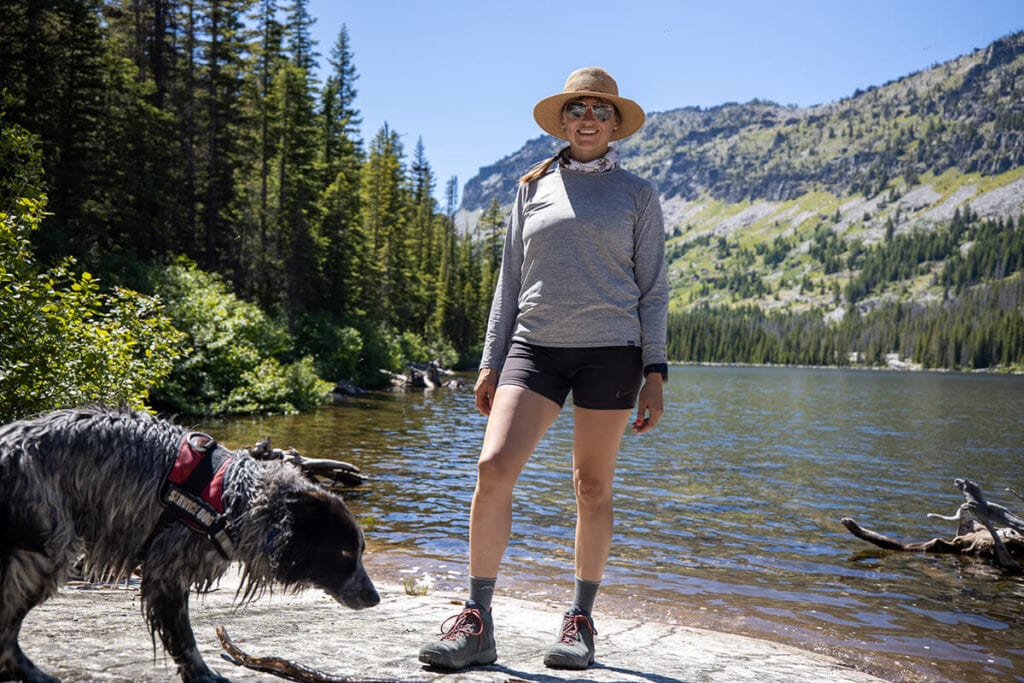
Mid-Weight Long Sleeve Layer
As I talked about in the first section, layering clothes is important to stay warm in changing conditions. If the weather takes a turn for the worse or you’re out longer than you think you’ll be and the temperatures start to drop, you’ll be happy to have a midweight baselayer with you.
One of my go-to choices for a mid-weight hiking base layer is the Patagonia RI. Maybe you’re seeing a trend here, but I like Patagonia apparel because of their environmentally friendly practices.
This mid-layer jacket is warm, yet breathes well and because of how small it packs down, I almost always bring this hiking and backpacking. I also wear it to bed on camping trips.
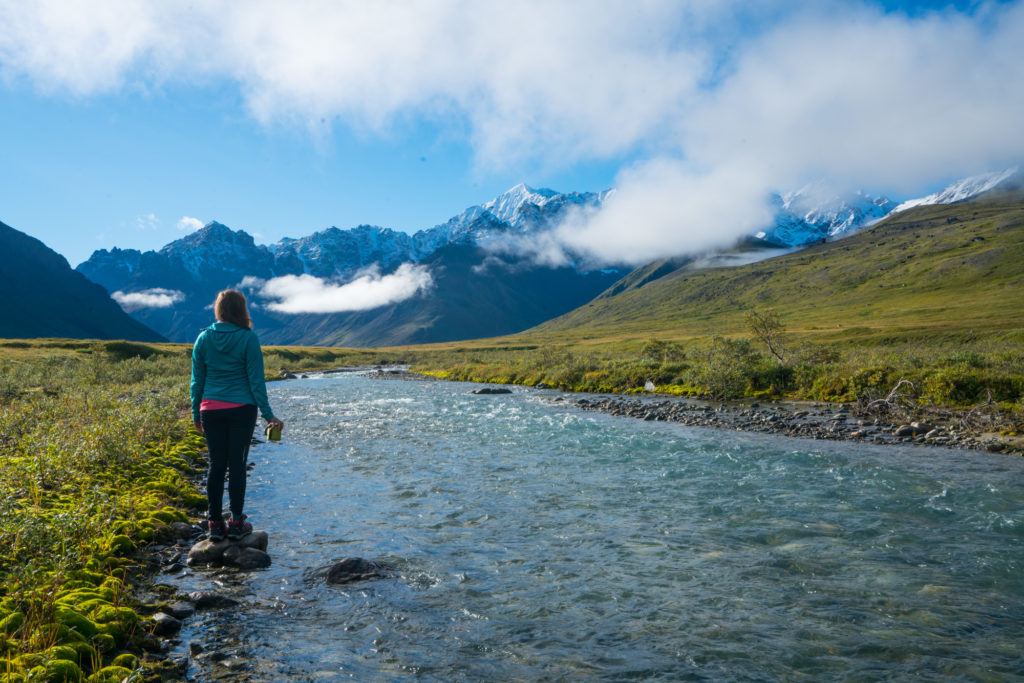
Hiking Jackets
Whether you choose a heavier insulated jacket or a lighter-weight jacket for your hike depends on the season and the climate you are hiking in. It’s best to err on the side of caution if you are hiking in the mountains, as weather can change quickly.
Here are my top picks for hiking jackets:
- Arc’teryx Kyanite Fleece Hoodie: If I need a lighter jacket as a “just in case”, the Arc’teryx Kyanite Fleece Hoodie is my go-to. I took this jacket with me to Italy and was really impressed with how it performed on cooler hikes. I layered it on top of my Patagonia Capilene shirt (see above) and it was perfect for cooler temps. This jacket is a bit bulkier than other lightweight jackets, but it breathes well so if you have the right layers on underneath, you should be comfortable wearing it throughout your hike.
- Patagonia Nanopuff: If I’m hiking at altitude and need a warmer outer layer, I bring my Patagonia Nanopuff. It’s a lightweight yet warm jacket with synthetic insulation that is good at cutting wind. I opt for the hooded version so I can keep my head warm if the weather gets nasty. Read my Patagonia Nanopuff review for more thoughts on this jacket.
- Patagonia Houdini: If you just need a lightweight windbreaker, the Patagonia Houdini is hands down the best lightweight windbreaker I’ve tried. This jacket is made for warmer weather where you want some protection from wind or bugs (or even the sun). The Houdini only weighs 3.4 ounces, so it’s really a no-brainer to throw in your pack if you’re hiking in an exposed area.
Read next: Looking for more jacket recommendations? Check out my post on the Best Women’s Synthetic Jackets.
Women’s Hiking Shorts
Any old shorts will do for hiking as long as they are comfortable. I personally like hiking in spandex/yoga shorts or loose shorts with an elastic waistband since these provide the most mobility. I much prefer shorts with pockets so I can keep my phone or other small essentials handy.
I also like all my hiking shorts to be a dark color since you often sit on rocks or the ground when you take breaks, and darker colors don’t get as dirty.
- Free Fly Pull-on Breeze Shorts: If you’re not a big fan of hiking in spandex or are looking for shorts that are more versatile, I love all of my Free Fly shorts. These have an elastic waistband for comfort, and the shorts are loose-fitting but not baggy or saggy. The material dries quickly, whether they are wet from a swim or stream crossing.
- REI Trailmade Shorts: These are budget-friendly hiking shorts. My favorite feature is the 6 spacious pockets! The elastic waistband doesn’t dig, and they are water resistant too.
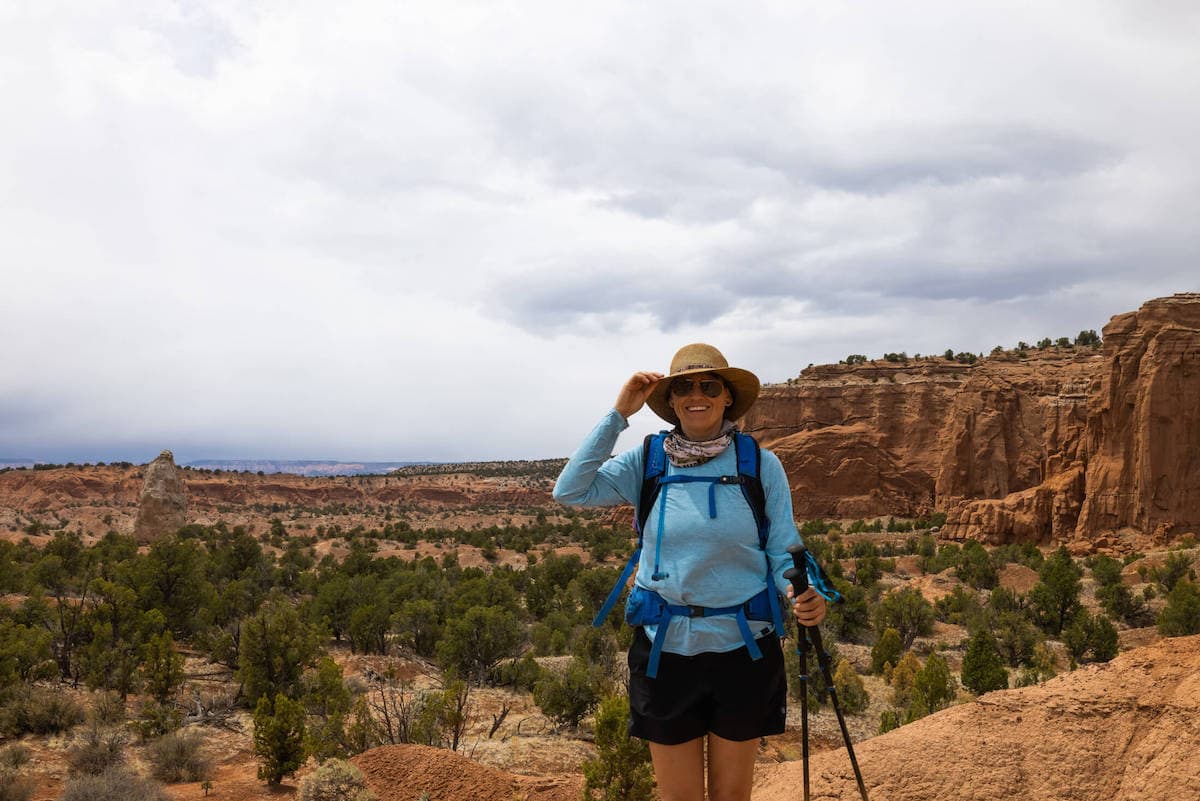
Read next: Looking for more recommendations? Check out our Women’s Hiking Shorts Gear Guide.
Women’s Hiking Pants
Women’s Hiking Leggings
If I’m hiking up high in the mountains, even in summer, I’ll often wear pants instead of shorts. The temperatures can be way colder at the summit vs at the trailhead, and wearing pants ensures I don’t get chilly as I climb. Pants are also better if there are bugs or if the trail is overgrown. Here are a couple pairs of pants I really like for summer hiking.
- lululemon Wunder Train High Rise 25″ tights: These leggings are great for warmer days, as they are breathable, and I don’t get too hot wearing them. They come in lots of fun colors (I personally prefer darker colors since they don’t show dirt as easily), and they also have a pocket large enough to carry your phone. The ones in the photo below are the 25″ length, but they also come in a 28″ length if you’d prefer them to cover your entire ankle). These are high-waisted and hit me just above the belly button, and the waistband doesn’t roll over when you move (which is a huge pet peeve of mine with leggings).
- Mountain Hardwear Dynama Pants: These are stretchy, lightweight, and extremely comfy and can be worn on the trail or around town. I like the ankle version because they are a little cooler, but they also come in a full-length version. I love the elastic waistband which doesn’t dig at all as you hike, and the loose fit means the pants breathe quite well. They also have deep pockets that can easily fit your phone.
Read next: Still shopping around? Find more great options over on my Best Women’s Hiking Pants and Leggings blog post.
Hiking Rain Gear
Should you bring a rain jacket on every hike? It’s important to know that the weather in the mountains can be unpredictable and you need to be prepared. Getting wet can not only be uncomfortable, but it can also be dangerous.
However, this doesn’t mean I bring a rain jacket on 100% of my hikes. I look at the forecast for the area I’m hiking in. If there is 0% chance of rain and I’m going on a short hike, then I will likely leave my rain jacket at home.
Now if I’m hiking at elevation, planning to summit a peak, or the trail is exposed and above the treeline, then it’s always a good idea to pack a rain jacket just in case.
Here are the rain layers I pack when necessary. See my tips for hiking in the rain and my favorite women’s rain jackets for more recommendations.
- REI Co-op Women’s Rainier Rain Jacket: This is a lightweight (and budget-friendly) rain jacket that will keep you dry if you end up hiking in the rain.
- Arc’teryx Beta SL Rain Jacket: This rain jacket is designed for the heaviest of downpours. It might be overkill for a summer hike in a mild climate, but if you want to invest in a rain jacket that can perform in the worst conditions, this is what I use. It’s got a fully adjustable hood, huge arm pit vents, and packs down into its own pocket. See my full Arc’teryx Beta SL Rain Jacket review here.
- REI Co-op Rainier Rain Pants: I don’t typically pack rain pants on day hikes unless the forecast predicts a decent amount of rain. These budget-friendly rain pants are great because they are full zip, so you don’t have to take your boots off to get the pants on.
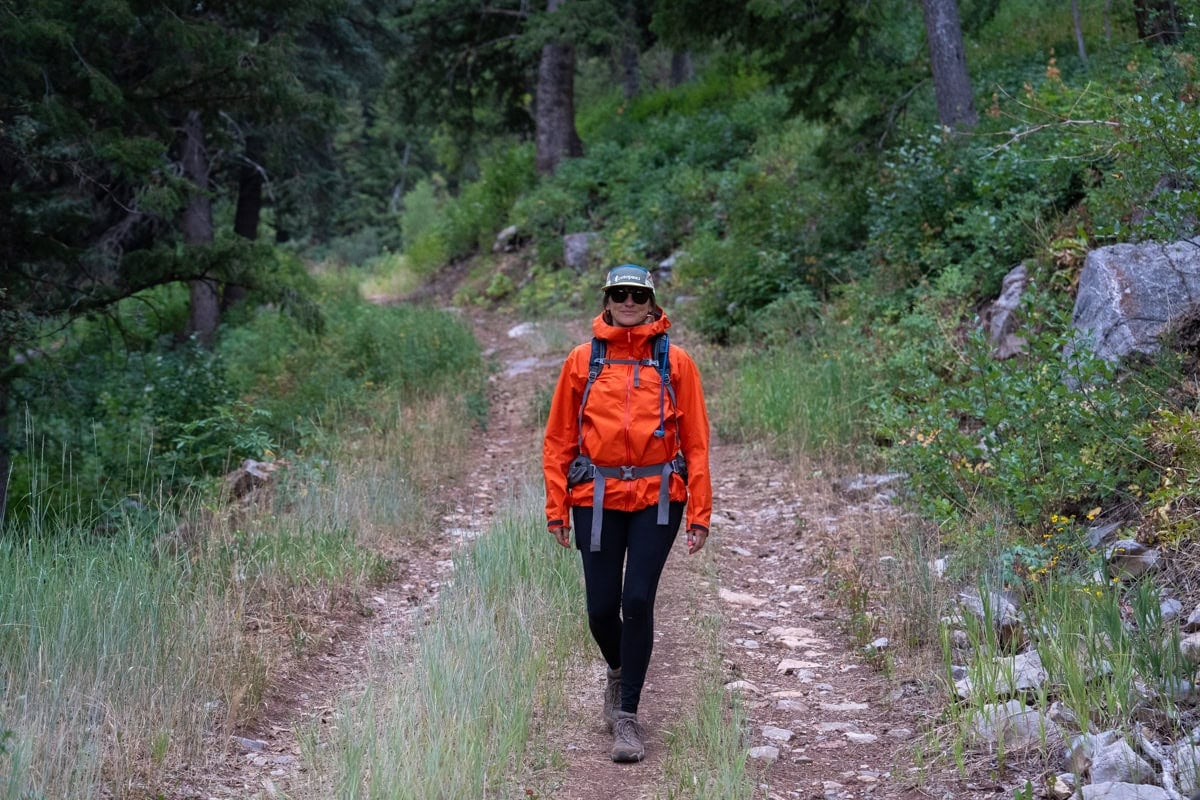
Hiking Undergarments
Choosing the right sports bra and underwear can make you a lot more comfortable. Here is what I typically wear on my hikes.
- Nike Swoosh Bra: Any sports bra that you can move comfortably and feel supported in will work well for hiking. I personally prefer ones that aren’t too strappy since they are easier to put on. I also avoid padding which makes me hot and underwire that digs. My favorite sports bra is the Nike Swoosh. I’m a 36D, and while it’s not supportive enough for running, it’s great for hiking. It’s got a simple design, wicks sweat, and can double as a bathing suit when you stumble on that perfect swimming hole.
- lululemon Invisiwear Midrise Boy Short: Quick-dry undies are essential for staying cool, dry, odor-free, and clean on the trail. After testing out dozens of different outdoor underwear, my favorites are these lululemon boy shorts. Being seamless, they don’t result in visible underwear lines, they breathe well, and generally stay put.
Hiking Footwear
Footwear is arguably one of – if not the most – important gear decisions for hiking. It’s essential to have a good pair of sturdy and comfortable hiking shoes with good traction, along with quality socks that can help prevent blisters.
Cotton socks aren’t great on the trail because they slide around and are infamous for causing blisters. Many hiking socks are made with wool which actually helps reduce sweating and keeps the sock snug against your foot to prevent unwanted rubbing.
Here is my go-to footwear for hiking in summer. For more recommendations see my post on the best women’s hiking boots.
- Oboz Katabatic LT Hiking Shoes: I’ve worn these Oboz Katabatic hiking shoes more than anything else while hiking lately. They are so much lighter than traditional hiking boots, while providing great traction and support. I mainly use the low ankle and non-waterproof version for warm summer hikes, but I also have the mid-ankle, waterproof version for burlier mountain hikes where I’m carrying a heavier load. For more thoughts, read my detailed Oboz Katabatic LT Review.
- Oboz Bridger Bdry Hiking Boots: If you like a more traditional hiking boot that’s more cushioned and designed for rugged terrain, the Oboz Bridger is my go-to. I usually reserve these for backpacking, but if you want a boot that will give you more confidence on steep, rocky trails, these are a great option.
- Darn Tough Hiking Socks: My preferred hiking socks are made by a company out of Vermont called Darn Tough. They are cushioned in all the right places and over 22 days with these on the John Muir Trail, I didn’t form a single blister.
Hiking Accessories
There’s a few accessories that I always wear on my hikes – mainly for sun protection. A hat and sunglasses are key for being comfortable when hiking on sunny days.
- Wallaroo Sedona Hat: I personally like wearing something that provides maximum sun coverage, and this my #1 favorite sunhat. It doesn’t obstruct my vision, it looks great with almost any outfit, and it has a string that you can tighten so it doesn’t fly off in windy conditions (Use the code BEARFOOT20 for 20% off).
- Cotopaxi Tech 5-Panel Hat: This hat is so light and cool, I hardly notice it on my head. It doesn’t provide as much protection as a full-brimmed hat, but it’s great to pair with a sun hoody. It comes in a bunch of fun colors too.
- Buff: Ever since I did my Everest Basecamp Trek, I love wearing a Buff when I hike. A Buff provides extra sun protection on your neck, and they can be used to cover your face in the wind.
- Roka Rory 2.0 Sunglasses: Any pair of sunglasses will do, but the pair I’ve been rocking for the last few years are the Roka Rory. They are lightweight and have no-snag nose pads, which means the nose pads don’t get stuck on your hair! Plus they block 100% of harmful UV rays and you can also get them with a prescription.
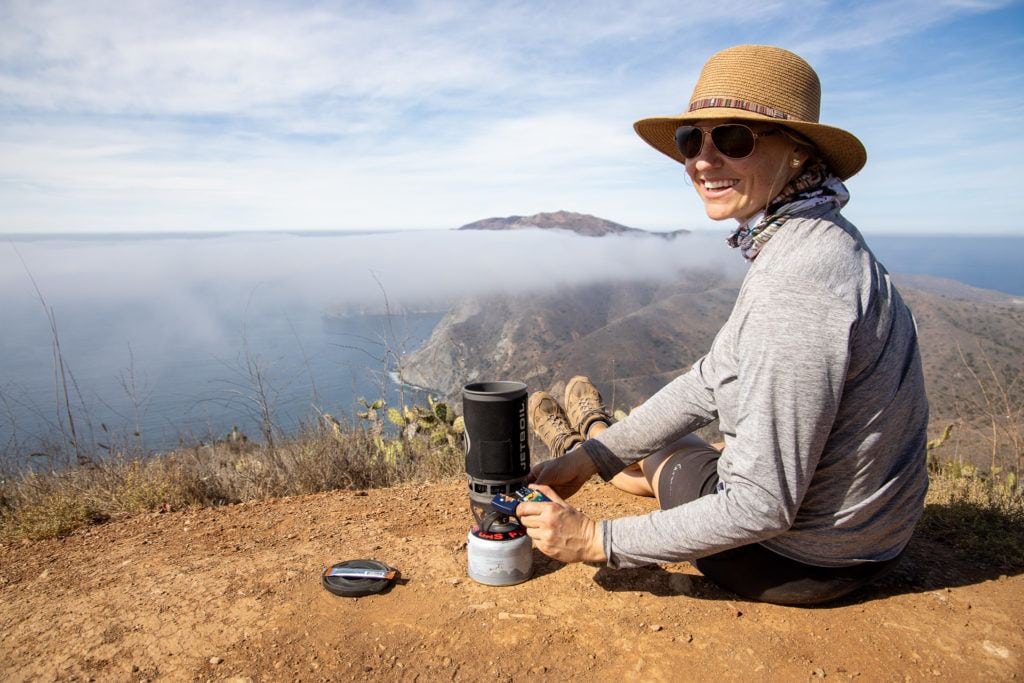
I hope this guide gives you a good idea of what to wear hiking so you can be comfortable and safe on the trail.
More Hiking Apparel Tips
Save this post to Pinterest
Do you have any hiking gear or clothing favorites? Let us know in the comments below!

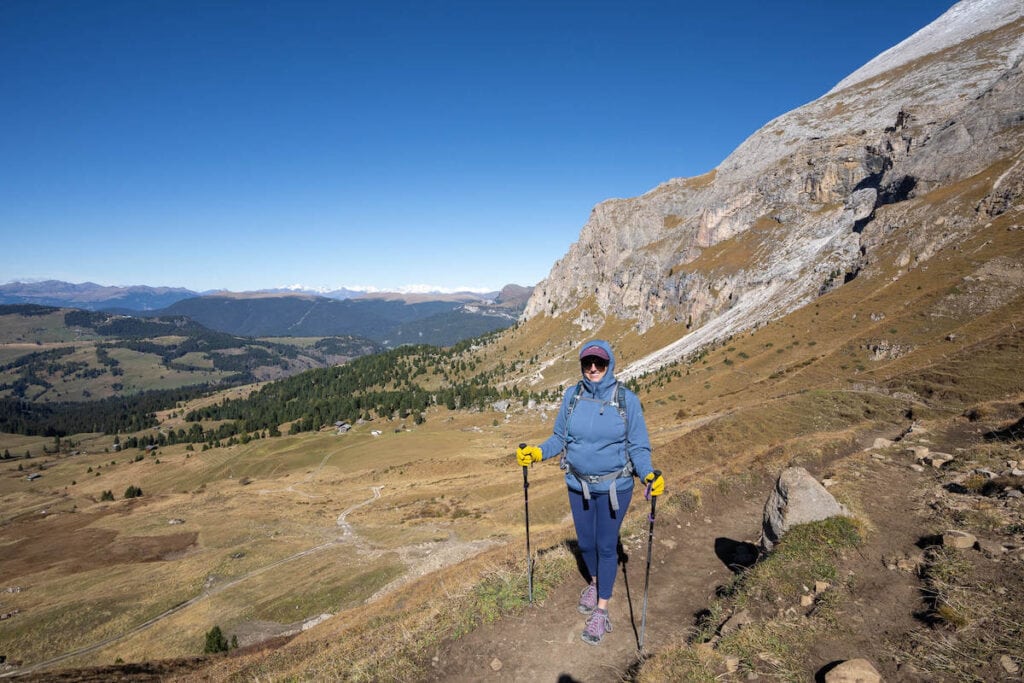
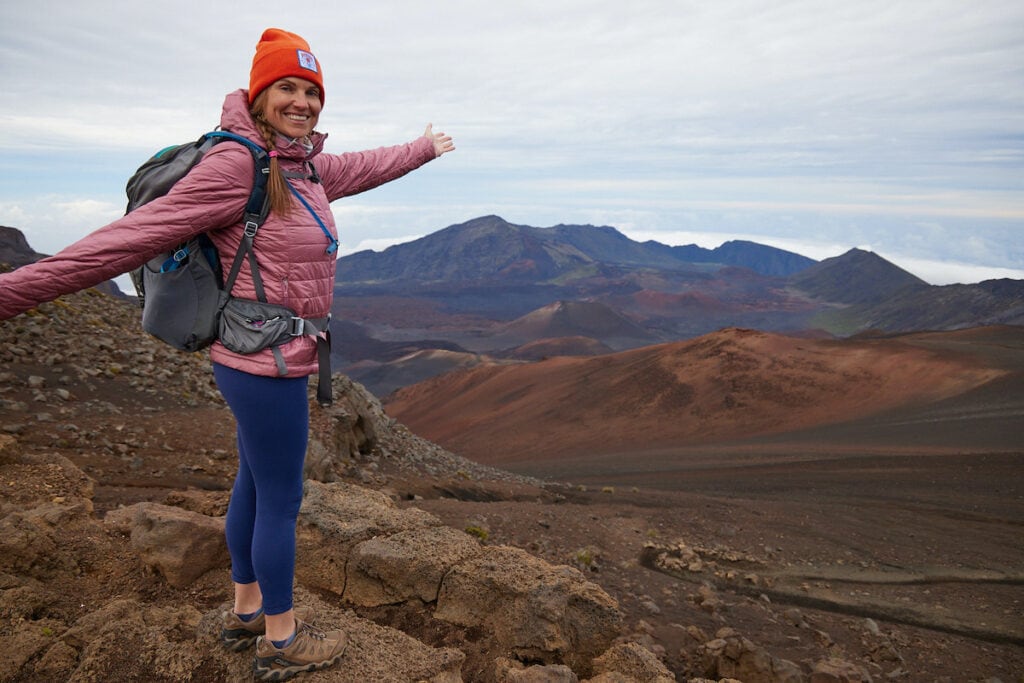
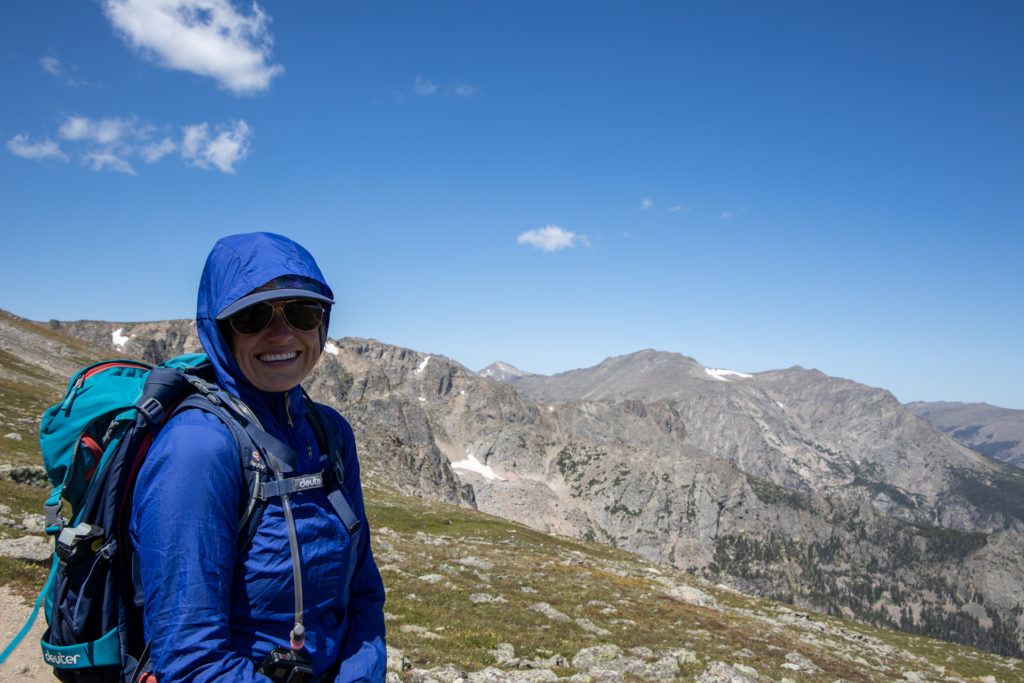
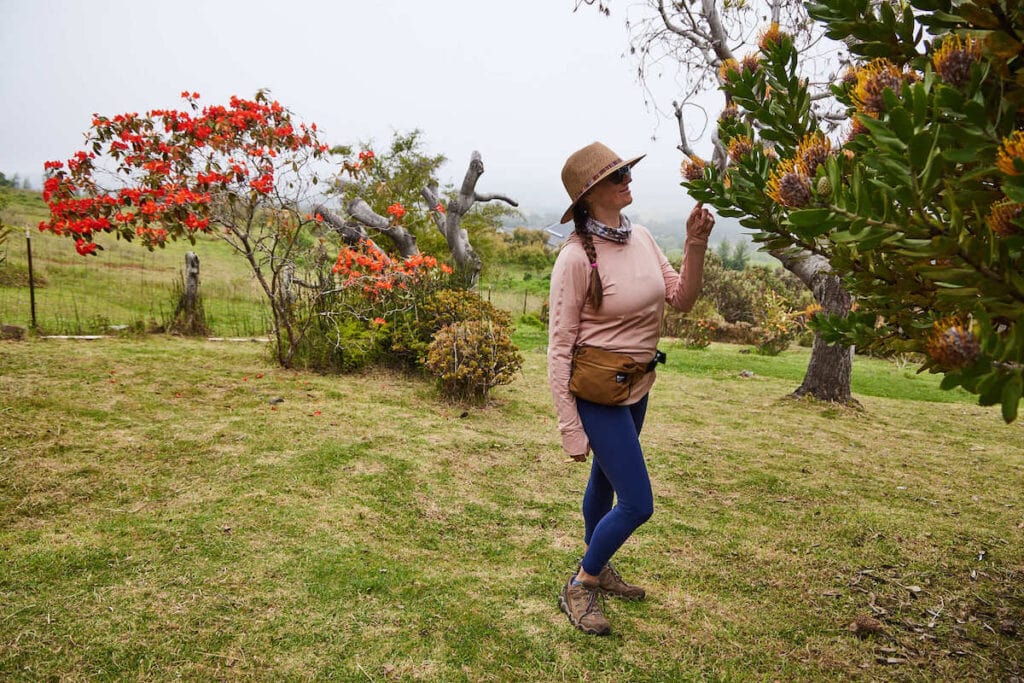
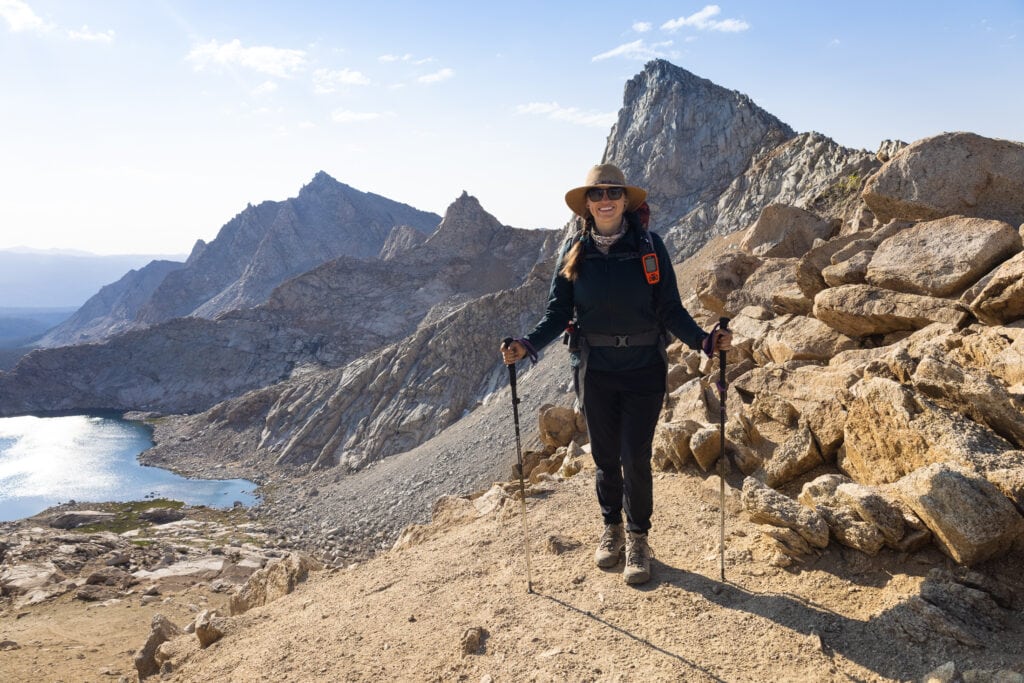
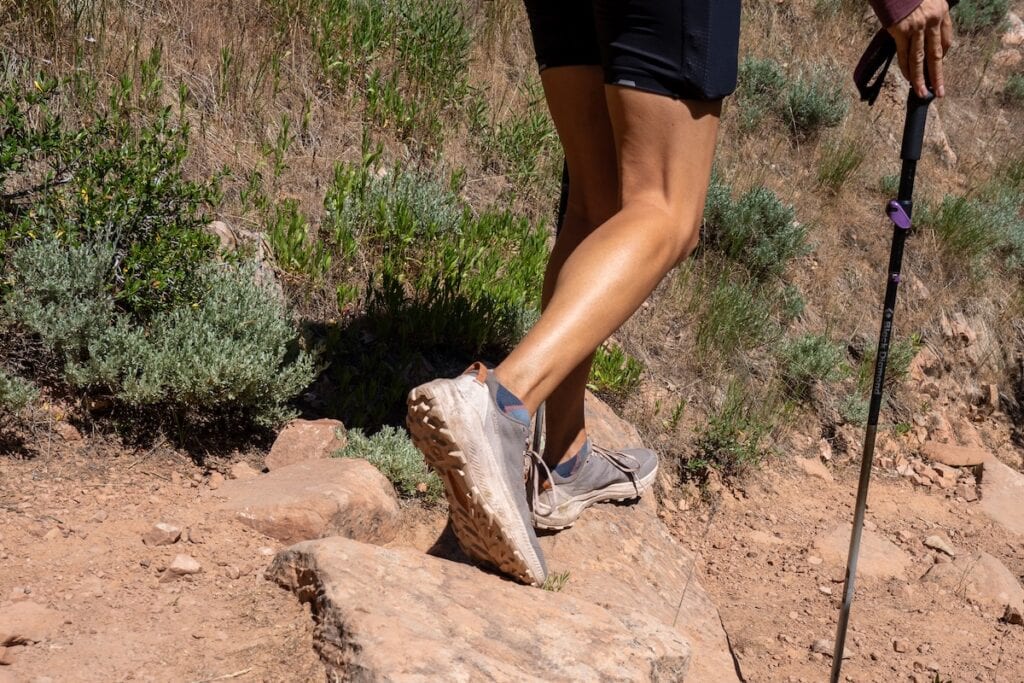

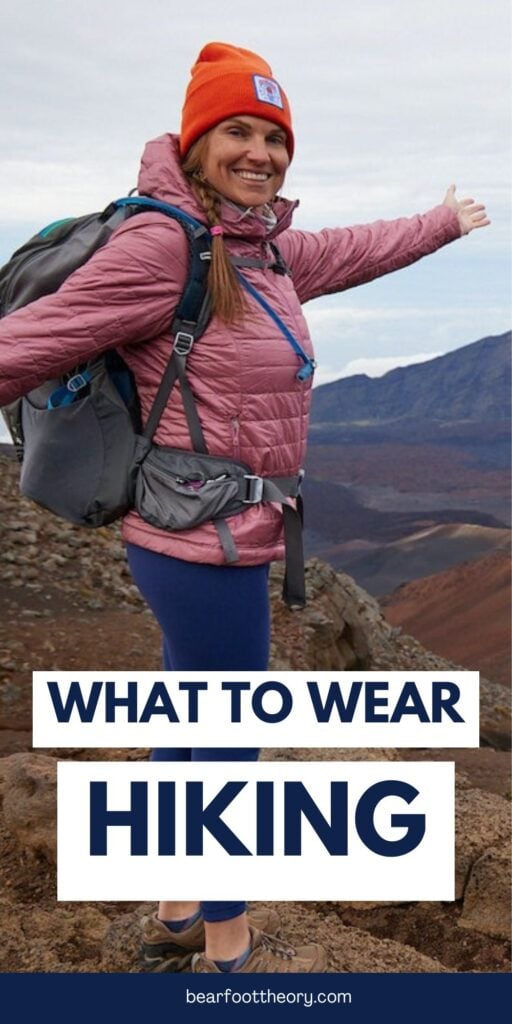
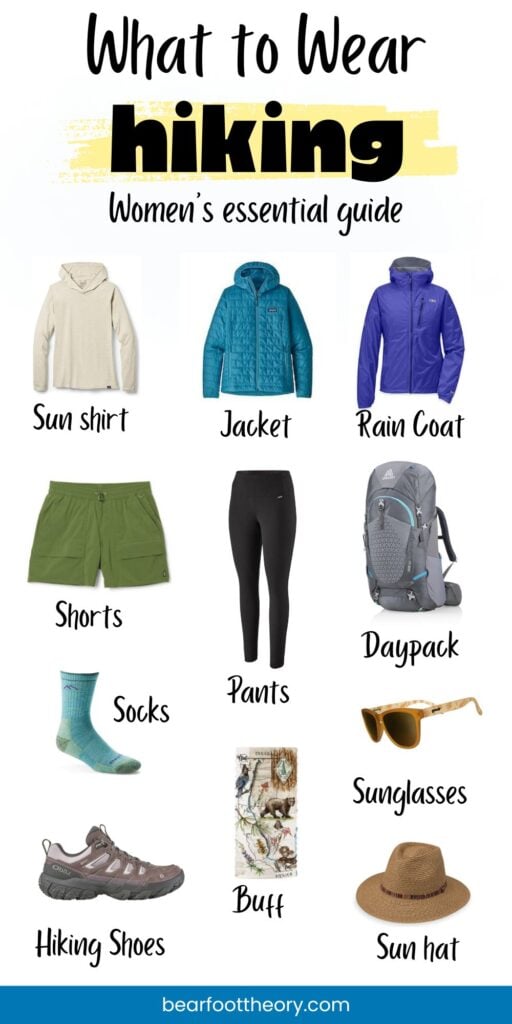
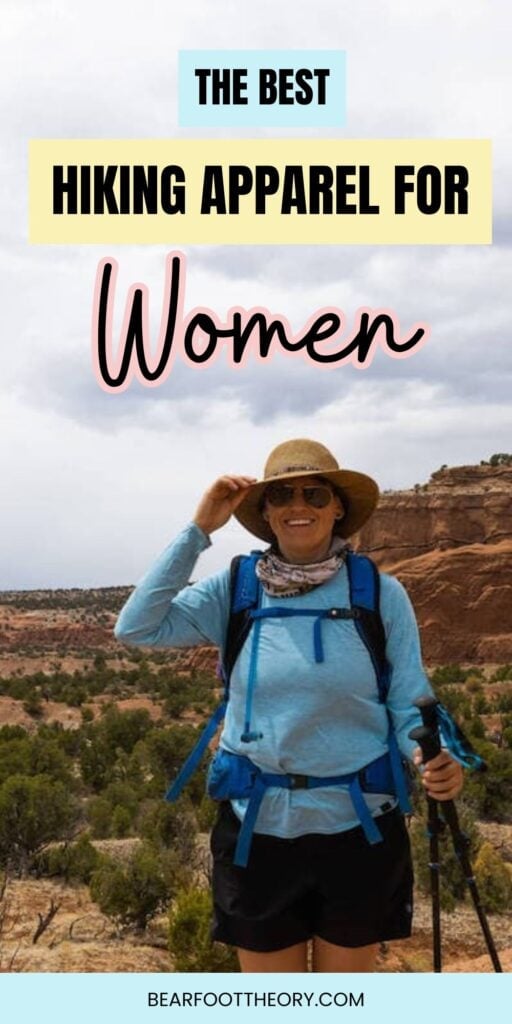
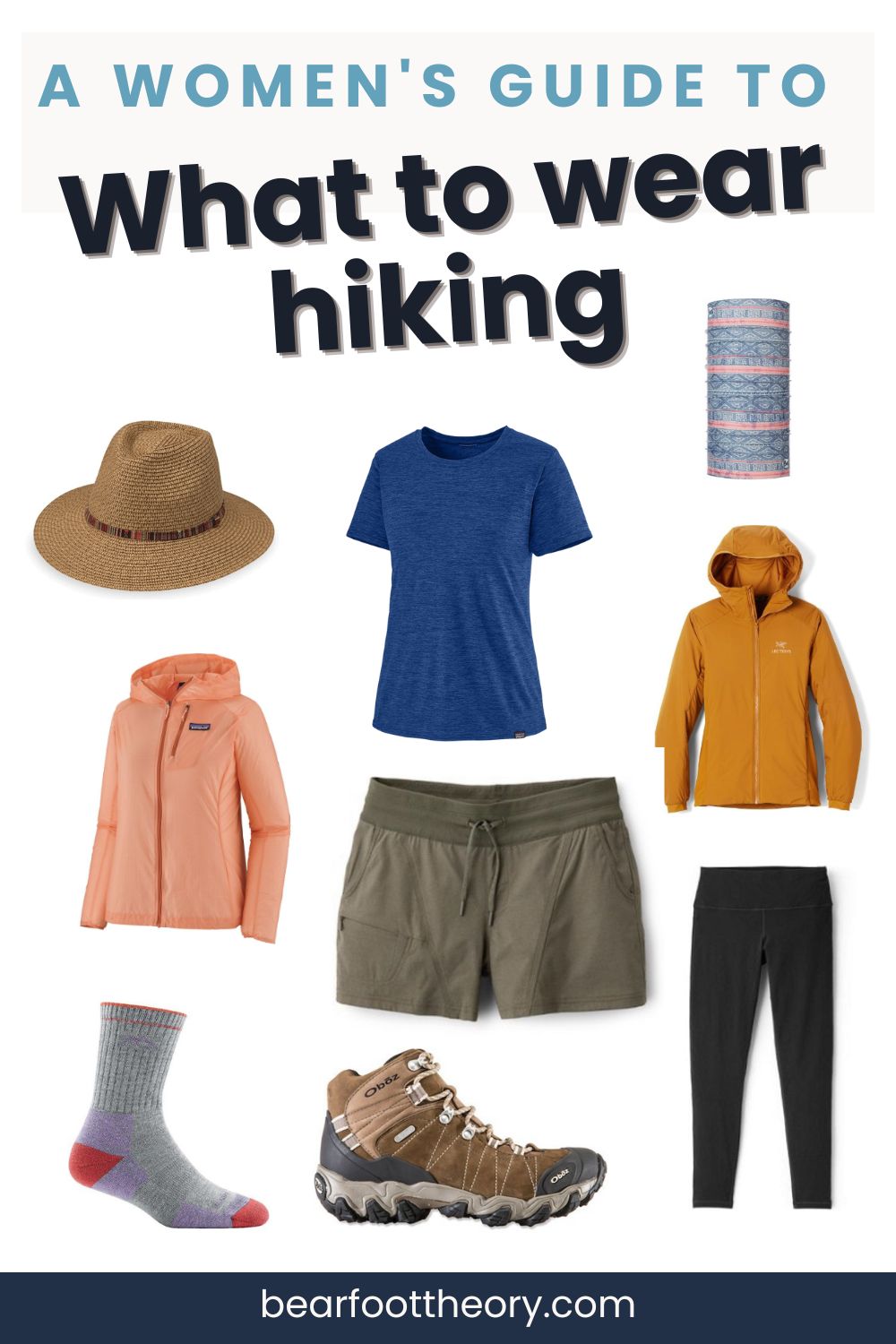
Nice list
Thank you!
Yesss, Darn Tough! So glad to see them getting a shout out…since I found them a few months ago, they’re the only sock I’ll wear running or hiking.
Same. I’m still wearing the two pairs that I took on the John Muir Trail a couple years ago and they are like new.
Thanks for the list! I love your site. I’m preparing for a JMT hike this summer in July and I’m trying to figure out which pants to bring: I have Marmot Lobo convertible hiking pants/shorts, leggings, and the same REI fleece pants you mention. The leggings are a little heavy, so I’m leaning towards leaving them behind, but it just feels strange to not bring leggings along. Thoughts?
Leggings are a must for me. I just got these Arcteryx leggings and I think they are going to be my new go to: http://bit.ly/22gDLDc I haven’t hiked in them yet, but I skied in them the other day and really liked them. I also like these tights by Mountain Hardwear: http://goo.gl/qTLBmx.
If you bring leggings then you can probably swap out the convertible hiking pants for a pair of shorts.
Hi Kristen! This post was super helpful! It looks like the Mountain Hardwear leggings are pretty much sold out everywhere now. Also, the link to the Arcteryx leggings doesn’t seem to go to a specific product. Do you have any recommendations for other leggings/tights? Thanks!!
Ah sorry about that and thanks for letting me know. I’ll update the post now with some new links.
Glad to see that my list matches your almost exactly! Different brands here and there but the same exact list. I’m a big fan of spandex shorts and pants specifically because my thighs touch and having anything baggy at all will leave me pretty chafed. Thanks for sharing!
These are great choices! My pack list is very similar, including the merino long sleeve and same Patagonia Nano Puff. The only thing I would add for those new to hiking/camping: Check out Uniqlo. The Heattech and Airism lines are a great and affordable option for base layers, underwear, etc. I also like their ultra light down vests for another packable layer.
When you did the JMT did you switch out of your boots and wear the Tevas for water crossings? Can’t really imagine hiking with wet shoes/socks! Thanks
It was a very Informative and helpful list but I understand it was mostly directed towards ladies. Leaving aside the socks, boots,rain jacket and down jackets, could you add something specifically for men. I mean with your experience you could easily gather what is popular among competitive male hikers.
This addition would make this a very comprehensive and wholesome piece.
In any case it was a very helpful article. Many thanks to you. And do keep writing your thoughtful and very practical article’s. I have found your blog the best among all others I have read till now.
Thanks and the very best.
i just bought myself the la sportiva nucleo gtx hiking boots and i absolutely love them! a sales person at rei recommended them, after i tried on about 3 pairs at the store. it felt so good after i put them on, they feel so light! i’ve hiked with them at yosemite and i love them!!
Angie, I have a pair of the La Sportiva Nucleo’s as well! Great to hear they are working for you.
Hi ! I just discuvered your blog and I really love it ! I am from France and live in a city close to the montains (Grenoble) and a blog like yours is like my bible ! Keep writting posts with a lot of advises for beginiers and others !
(sorry for the mistakes, I am not used to write in English!)
Thank, Milla, for stopping by!
Thank you for the list!
Great guide dear. Very informative. I recently researched and wrote an article on best hiking shoes for women that are comfortable and stylish. It seems companies out their focus on comfort than how the gear looks. I guess for me as long as the boots are comfy, waterproof and kinda chic, I will be happy.
hello just wondering what month you went in and how cold was it?
Hi Maddy, we hike year-round. Is there a specific trail you are inquiring about?
Merci pour tous les bons conseils!
Reste une question… Je devrai marcher à peu près 25 km par jour pendant 6 semaines sur un terrain de difficulté moyenne à difficile avec des montées et des descentes, dans un climat chaud variant de 10 à 30 degrés.
Je me demande encore si je dois opter pour des souliers de marche avec ou sans GORE-TEX.
Le GORE-TEX me tiendra au sec de l’extérieur en cas de pluie mais rendra mes pieds humides à l’intérieur et donc risque d’ampoules.
Le GORE-TEX est parfait pour l’hiver mais pour l’été, je n’en suis pas si certaine. J’ai l’impression qu’ils seront trop chauds.
Que me conseilles-tu?
Hi Jocelyne, you are right that Gore-Tex might be a bit too hot in the summer. If you’re going to be hiking in a warm climate you might want to consider a more breathable option. Also don’t forget to pack extra socks and change socks frequently. When I hiked the Pacific Crest Trail (20+ miles a day) I often changed my socks at least 3 times a day; this helps keep your feet dry and protects you from blisters.
Hi there
i Work as a mountains guide in morocco atlas mountains i did a lot of treks with a lot of people its very usefull for me what you mentioned in your article thank you very much
In your picture where you are standing by the JM Wilderness Inyo sign – what is hanging off your pack waist belt (orange) and what do you use it for? Thx
Great list!
Totally team hiking leggings! Don’t go without anymore 😀
Nothing else to add besides: I also “wear” natural sunscreen on my skin and self-made lip balm on my lips 😉
You made such an interesting piece to read, giving every subject enlightenment for us to gain knowledge. Thanks for sharing the such information with us to read this…
Hi I also work with tourists, as a mountain guide, and what you write on your article is very useful for me, thank you
Glad you found this helpful 🙂
thank you for this article
Great
jennifer
The hiking Pants on this list are really impressive. I think good hiking apparel shouldn’t sacrifice comfort over functionality and brands like https://coalatree.com/products/trailhead-pants have mastered this and I really love how the quality of products they make because of this!
Hiking is one of the best adventurous sports and I have always wanted to try it with my friends. Thanks for sharing these wonderful insights on clothes required for hiking.
Hello Kristen,
Thank you for the wonderful tips. I have been getting into hiking for the last couple of months, as it is a great activity and I am able to spend more time outside. I still have not bought the whole equipment, as it is an investment and I do not want to spend that much money in one go… Something that I have to invest in, are the shoes… I have been using timberland shoes and impregnated the shoes, for them to be waterproof as I think it is very important, after reading the pros about waterproofing shoes here: https://nano-care.com/products/impregnation/
Do you think the shoes should be higher up in my must buy equipment, or do I get along fine with my Timberland shoes?
Thank you
It really depends on what kind of terrain you’re hiking in. If you’re hiking in wet conditions, a fully waterproof might be worthwhile. But if you’re hiking on mostly dry trails, your Timberlands should be fine. For more info on waterproof vs non-waterproof hiking boots, check out this blog post.
It’s very nice idea to write an article for this topic. I noticed that many people can’t understand about their trekking clothes so i will share this blog with them. I am sure this article will be very helpful to your readers. Keep sharing your ideas!
Great information! Thank you for sharing with us. Keep sharing…